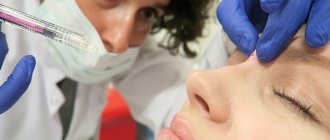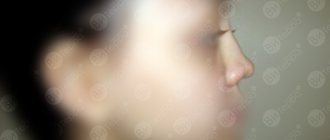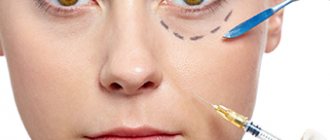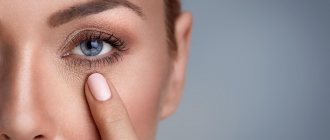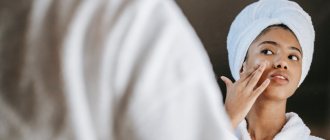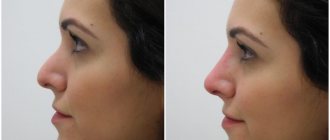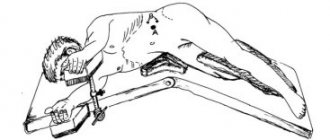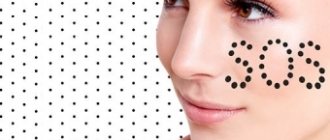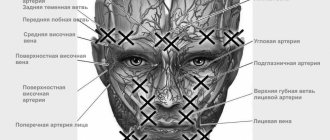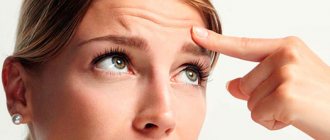You can correct the shape of your nose without surgery!
An individual approach to beauty without surgery.
- Cause of a hump on the nose
- Advantages of the nasal hump correction method without surgery
- How is the nose correction procedure performed without surgery?
- Effect after removing a hump on the nose without surgery
- Contraindications
- Cost of non-surgical nose correction
- Questions from patients about the non-surgical method of correcting nasal defects
The nose gives the entire external image a certain character. An “angular” shape or a pronounced hump on the nose can create the impression of rough or too sharp facial features, which do not always suit women and even some men. That is why such aesthetic defects are eliminated with the help of rhinoplasty - a surgical operation that allows you to correct the shape of the nose and general facial features.
However, many patients do not want to go to the surgeon, fearing anesthesia, long-term rehabilitation, which is inevitable even if all manipulations are carried out correctly, as well as natural complications characteristic of the first weeks of the recovery period.
How to remove a hump on the nose without surgery and is it possible? Yes, such a solution exists.
At our Armida clinic, they can offer you an alternative solution to the problem and help you remove the hump on your nose without surgery. Patients sometimes call this technique “non-surgical rhinoplasty,” although in reality it has nothing to do with plastic surgery.
Correcting the nose without a scalpel will not help eliminate pronounced defects and completely transform its shape, however, with its help it is easy to remove the hump and slightly change the overall outline. The essence of the method is the injection of a special filling gel into the problem area. The hump visually decreases or disappears completely due to the visual alignment of the dorsum and depressions; the shape of the nose changes without surgery.
Indications for correction
This is a very popular operation - more than 50% of patients who want to correct the shape of their nose at the SM-Plastic clinic want to get rid of the hump. This anatomical feature often looks disproportionate and makes the appearance of the face too massive. A hump looks especially unfavorable if the nose is long and narrow or, conversely, too large. Therefore, purely cosmetic, aesthetic reasons are the most common reason.
The cause of a hump on the nose is injury - fractures of the cartilage or bones of the nose. In this case, it can worsen respiratory function, and this is a medical indication for correction, which is often carried out simultaneously with correction of the nasal septum.
Individual consultation
Thank you for your application. Our operator will contact you from 8:00 to 22:00 Applications received after 22:00 will be processed the next day.
How to remove a hump on the nose without surgery
There are several ways to treat the problem without surgery:
- Gymnastics by Carol Maggio . It can be performed in any position. The main thing is regularity. To do this, lift the tip of the nose with your finger and stretch the lips. Next you need to try to lower your nostrils. This position is fixed for several seconds. It is recommended to repeat the exercise twice a day 35 times.
- Massage . You will need a folded scarf heated with an iron. Place it on the ledge, press firmly and hold for 30 seconds. Repeat six times a day. After two weeks you may notice slight changes.
- Makeup . Using cosmetics for sculpting, you can disguise a defect and visually correct the shape of your nose.
All of these methods have a significant drawback - a subtle or temporary effect. You should not count on completely eliminating the problem.
How to correct a hump at SM-Plastic
For surgical correction of the nasal bridge, direct removal of excess tissue or grinding is used. Direct removal is performed in two ways: open and closed. The open technique involves making surgical incisions on the outer surface of the nose. This gives the surgeon the opportunity to accurately visually control his actions, but after the operation the scars will remain visible for some time. The intervention is carried out in a closed way through the nasal passages. The view of the surgical field will be worse here, but no visible traces will remain.
In both cases, direct rhinoplasty begins with the release of the bone and cartilage base, which forms the hump. The doctor then removes part of the bone and part of the cartilage, creating a straight line, and closes the incision with cosmetic stitches. The operation is performed under general anesthesia and lasts 1–2 hours.
Grinding is a simpler and more gentle correction method. In this case, excess periosteum and cartilaginous tissue are removed with a special knife-raspatory, as if “grinding” the back of the nose. This method is less traumatic. In addition, if you remove the nasal hump by grinding, the cost of the operation will be lower. But this technique is applicable only when the defect is mild.
Stages of rhinoplasty surgery
The operation takes place in several stages:
- Creating access to the hump. Plastic surgeons at our clinic use closed and open techniques. In the first case, access is made through incisions made from the nasal passages. When using this technique, the resulting scars are not visible from the outside. The open surgical technique involves cutting the skin and lifting the soft tissue. The surgeons at our clinic perform open rhinoplasty so carefully that after the operation the suture line is not visible;
- Removing the hump. First, the surgeon cuts off the cartilaginous formations, then meticulously and carefully excises the bone tissue;
- Bringing the side slopes into the desired position. The nose turns out harmonious, the desired roundness, width and height;
- Tip formation. This stage of the operation is not always present. It is necessary if the patient has a narrow, elongated nose;
- Stitches and plaster cast. The surgeon places tampons into the patient's nasal passages. They support injured tissue and reduce swelling.
Recovery after surgery
After the intervention, the nose is covered with a fixing bandage, which will have to be worn for the next two weeks. During this period, avoid hot, cold or spicy foods, minimize physical activity, movements of facial muscles, avoid hot showers and wearing glasses. Particular care should be taken when putting clothes on over your head. Swelling of the tissues of the nose and face may persist for 1–2 months - during this time it is better to sleep on your back with your head elevated.
The result of surgery will be the elimination of the bulge on the bridge of the nose. In profile, it will look like a straight line, which will ensure correct facial proportions and make your appearance more sophisticated and graceful. Often, correction of a hump requires simultaneous correction of the shape of the wings of the nose - thanks to this, the most natural effect is achieved.
You can make an appointment with a qualified SM-Plastic surgeon and find out the details and cost of the procedure by filling out the feedback form on the website or calling in Moscow: +7.
Our advantages
Experienced surgeons
Modern equipment
Free consultation
Affordable prices
European service
Rhinoplasty - photo results
Rhinoplasty of the nasal dorsum.
Patient I., 27 years old.
The patient had an injury 5 years ago. Before the operation, there was deformation of the nasal bridge and difficulty in nasal breathing.
A combined operation was performed: rhinoplasty and septoplasty. This operation is performed at the ViTerra clinic by otolaryngologist and plastic surgeons simultaneously. The format of the multidisciplinary clinic allows this intervention to be performed with maximum clinical effect, in the minimum time and in the most comfortable conditions for the patient. A modern operating room and leading anesthesiologists in Moscow allow us to avoid all possible complications during this combined operation.
Photo before
Photo after, 3 months later.
Complete recovery and pronounced aesthetic effect.
The cost of the operation, together with anesthesia and observation in a day hospital, was: 148,000 rubles .
Congenital defect of the back and tip of the nose
Patient V., 36 years old.
She complained of a congenital defect in the back and tip of the nose.
An operation was performed: rhinoplasty (back and tip of the nose). The patient was in a day hospital for 1 day after this operation, under the supervision of doctors - an otolaryngologist and an anesthesiologist. The patient was observed as an outpatient at the clinic every 3 days. On the 10th day, the fixation cast was removed and the patient was discharged.
Photo before
Photo after, after 1.5 months
The total cost of treatment and observation of this patient at the ViTerra clinic was: 160,000 rubles.
Difficulty in nasal breathing and visually pronounced deformation of the nasal bridge
Patient I., 43 years old.
Was injured as a result of an accident. The patient was bothered by difficulty in nasal breathing and visually pronounced deformation of the nasal bridge.
A combined operation was performed at the ViTerra clinic: rhinoplasty, septoplasty.
Photo before
Photo after, after 3 weeks
The patient was discharged with positive cosmetic and functional results.
The total cost of treatment and observation in our clinic was: 180,000 rubles.
Deformation of the external nose, hump of the nasal bridge, difficulty in nasal breathing
Patient E., 35 years old.
I had a nose injury about 5 years ago. The revealed diagnosis: deformation of the external nose, hump of the nasal bridge, difficulty in nasal breathing.
An operation was performed: rhinoplasty + septoplasty.
Photo before
Photo after, 4 weeks
After completion of treatment in our clinic, a pronounced aesthetic and physiological effect was observed.
Photo after, 4 weeks
Photo after, after 6 months
The cost of treatment was: 180,000 rubles.
Pronounced hump of the nasal bridge
Patient Z., 29 years old.
She complained of a pronounced nasal hump, which caused her psychological discomfort.
The patient underwent surgery: rhinoplasty (removal of the nasal hump).
Photo before
Photo after, 1 month
The cost of treatment was: 90,000 rubles.
Nose injury as a result of an accident
Patient T., 38 years old.
Ten years ago, the patient suffered a nose injury as a result of an accident. Before admission to our clinic, the patient underwent surgery: rhinoseptoplasty. After 4 years, the patient came to our clinic with complaints of severe deformation of the external nose.
An operation was performed: rhinoplasty.
Photo before
Photo after
The cost of the operation was: 95,000 rubles.
Contraindications for rhinoplasty
In rhinoplasty, as in other surgical interventions, there are contraindications. But here is an important point. Some of these contraindications are what are being treated (they are collected in the first list below). The second list contains more serious cases.
So, the first list: !!️frontitis, rhinitis, sinusitis, otitis media, sore throat; ️viral or infectious (ARVI, acute respiratory infections); ️rinovirus, adenovirus, rotavirus infections; ️typhoid fever, simple herpes; ️acne, carbuncle, erysipelas, folliculitis. ⠀ Second list: ❌ type 1 or type 2 diabetes; ❌ heart disease; ❌ infectious diseases (for example, Epstein-Barr viruses, Ebola, gonorrhea, brucellosis, tuberculosis, aspergillosis, meningitis; ❌ HIV; ❌ cirrhosis, diabetes, hepatitis, systemic lupus erythematosus; ❌ Graves' disease and allergic reactions; ❌ chronic liver diseases, such such as hepatitis, cirrhosis, hemochromatosis, alcoholic, toxic or chemical damage to the liver; ❌ oncology; ❌ bronchial asthma, chronic and acute bronchitis; ❌ blood clotting disorders; ❌ a number of mental illnesses. ⠀ In general, it is worth recalling that no matter what operation was carried out - the patient undergoes a mandatory examination, takes the necessary tests. Because sometimes a person himself may not be aware of the presence of a particular disease. In the pursuit of an ideal appearance (if we talk about the aesthetic part of rhinoplasty), do not forget about your health in general!
Rehabilitation after surgical correction of the hump
Open rhinoplasty with removal of a bony protrusion on the nasal septum is a fairly traumatic operation, which is accompanied by large swelling. To make rehabilitation after surgery simpler and easier, you must follow the recommendations of the plastic surgeon:
- For 1 month after rhinoplasty, it is forbidden to play sports, perform any physical activity, visit the sauna, or take a hot bath.
- Avoid natural tanning and going to the solarium for 6 months after surgery.
- It is recommended to attend physical procedures, which shorten the rehabilitation period and speed up the healing process of nasal tissue. This could be lymphatic drainage, microcurrents. But remember that only a plastic surgeon can prescribe physical procedures after a personal consultation with the patient.
- During rehabilitation, you should take all medications prescribed by your doctor. They will help avoid nasal congestion, tissue infection, dry eyes, and severe swelling.
The surgeon can remove nasal tampons only on the 5th day after surgery, when the risks of early complications have passed. The sutures will be removed by a plastic surgeon on the 10th day after rhinoplasty of the nasal hump. The final result of the plastic surgery can be assessed after 6-12 months, when the swelling has completely subsided and the final shape of the nose has formed.
Do you need hump rhinoplasty? Make an appointment at the plastic surgery clinic for a consultation with surgeon M.A. Aspen. The doctor will examine your nose and suggest the best option for hump surgery.
The information on the site was personally verified by plastic surgeon Maxim Aleksandrovich Osin; if you have any additional questions, call the phone number listed on the site.
Who determines the method of surgery?
The method of operation is determined, of course, by the surgeon, taking into account the anatomical features, expected changes and the possibilities of their implementation. Before deciding to have surgery, it is important to understand how necessary it is? After all, there are cases when after rhinoplasty the result may not meet expectations, or correction or revision surgery will be required. Here it is important to understand that there may be shortcomings, the main thing is their adequate assessment by both the surgeon and the patient.
You've probably thought about rhinoplasty if you have:
- Long, hooked, Greek, Roman, bulbous nose
- A nose that is disproportionate to other facial features (large or asymmetrical nostrils; a large, overly upturned or drooping tip; a dorsum that is too thick, thin, or uneven)
- Difficulty in nasal breathing in combination with the above symptoms
Our patients often have a question: does the surgeon work on the septum during rhinoplasty? The answer is yes, at least for cartilage harvesting, and also when it is necessary to perform septoplasty if it is curved. Another question: who should do this operation? Someone who knows how to perform interventions safely, no matter if it is an ENT surgeon or a plastic surgeon.
It is important to understand that a good result is a relative concept for this operation and is determined, among other things, by the original shape of the nose, the structure of the cartilage, and the quality of the skin. All the shortcomings of primary rhinoplasty can be corrected if desired - this is the main thing that the patient should know.
Primary rhinoplasty is performed to remove aesthetic defects, correct the shape and size of the nose, remove curvature, hump, etc. Repeated intervention is intended to correct the mistakes of the first operation or complications that may arise during the rehabilitation period and later. The nose is breathing, smelling, aesthetics. The nose has a unique ability to humidify and purify the air entering through it. In this way, our lungs receive what ensures the proper functioning of the entire body. Accordingly, disruption of the intranasal structures has a bad effect on the functioning of the brain and heart; we stop smelling, depression and fatigue occur, performance decreases, and chronic hypoxia develops. ⠀ Do you think there could be cases when the septum is straightened, the shells are reduced, but nasal breathing still does not improve? Definitely yes. And this may be due to nasal valve insufficiency. External valve insufficiency is directly related to the lower alar cartilages. Internal - with upper lateral cartilages. And the nasal septum and inferior turbinates play a key role and are an integral part of the nasal valves. ⠀ The nasal septum is like a skeleton, a base, and the cartilages of the external nose form a frame, which is covered by the skin on top. When a deviated nasal septum and valve dysfunction are combined, it is necessary to use various rhinoplasty techniques. At the same time as eliminating the deviated septum, you can change the shape of the nose, remove the hump, and straighten the tip.
Doctors
Removing a nasal hump is one of the most difficult rhinoplasty operations. The complexity of the operation lies in the fact that the surgeon has to work simultaneously with two types of tissue (cartilage and bone), which requires the highest level of surgical skill and considerable experience. The surgeons at the JSC Meditsina clinic in Moscow are specialists of the highest category who are proficient in the most modern rhinoplasty techniques and have extensive experience in performing operations of varying complexity.
You can get more information about the clinic’s doctors and sign up for a consultation on the website of JSC “Medicine” (academician Roitberg’s clinic) in the “Our Doctors” section.
Why is the shape and proportions of the nose so important for appearance?
The nose occupies a central position on our face, and in profile it is the most protruding, and therefore the most noticeable part of it. The attractiveness of the face as a whole often largely depends on how harmoniously the shape of the nose looks together with the rest of the facial features. A hump that is too prominent and noticeable can give an angry, unfriendly, rude expression and significantly increase age. In such cases, the hump must be corrected to change the facial expression for the better.
Women are especially picky about their appearance, and their dissatisfaction with a hump can negatively affect their perception of their own attractiveness. Correcting the hump of the nose will help add sophistication, femininity, and most importantly, increase self-esteem and add self-confidence. As a result of removing the hump, the eyes and lips will look larger and more expressive, the cheekbone line will become more emphasized, the oval of the face will be gentle, and the smile will be attractive. Elimination of this small aesthetic defect can emphasize the individual characteristics of the face, making the features more attractive and harmonious, regardless of the patient’s age.
A hump is one of the most common defects, the presence of which is due solely to the structural features of osteochondral tissue, which can be either congenital or acquired. Heredity, improper fusion of the bones and cartilage of the nose after injury, and even long-term wearing of glasses with heavy frames - all this can cause the appearance of this defect on the nose. The most effective way to get rid of this deficiency is rhinoplasty.
